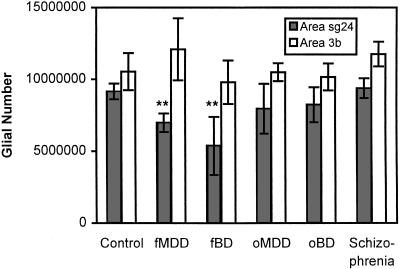Figure 2.
Mean glial number estimates and standard errors in areas sg24 and 3b for the brains obtained from the Stanley Foundation (∗∗ indicates P = 0.01 compared with the control group). Group abbreviations fMDD and fBD indicate cases with a clear family history of the disorder while oMDD and oBD indicate cases without a clear family history. Note that the oMDD and oBD groups may include familial cases where there was not sufficient evidence to clearly establish a family history of mood disorders. For example, two of the oBD subjects had very low glial counts. Of these, one had first degree relatives with alcoholism, obsessive–compulsive disorder, and depression while the other had negative family history, but the paternal side of the family was said to be “hyperactive” and had “lots of energy.” These descriptions of the relatives are potentially compatible with a bipolar pedigree (8).

